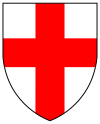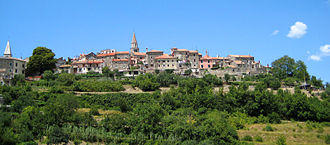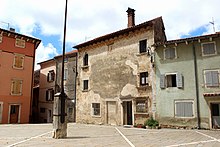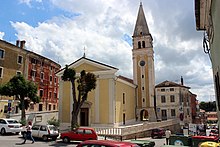Buje
|
Buje Buie |
|||
|
|||
|
|
|||
| Basic data | |||
|---|---|---|---|
| State : |
|
||
| County : |
|
||
| Height : | 222 m. i. J. | ||
| Residents : | 5,182 (2011) | ||
| Telephone code : | (+385) 052 | ||
| Postal code : | 52 460 | ||
| License plate : | PU | ||
| Structure and administration (as of 2017) |
|||
| Community type : | city | ||
| Mayor : | Fabrizio Vižintin ( IDS ) | ||
| Postal address : | Istarska ul. 2 52460 Buje |
||
| Website : | |||
Buje (Italian Buie or Buie d'Istria ) is a town in Istria County , Croatia . The municipality of Buje has almost 5,200 inhabitants, of which almost 2,700 live in the city center.
Settlements
The municipality of Buje consists of the following settlements (Croatian naselje) (population according to the 2011 census):
|
|
The towns of Bužin, Škrile, Škudelini and Veli Mlin are controversial between Croatia and Slovenia .
population
According to the 2011 census, the municipality of Buje has 5,182 inhabitants, of whom 2,530 are male and 2,652 female.
According to ethnicity, 48.7% of the inhabitants of the municipality were Croatians , 24.3% Italians , 3.5% Serbs , 3.3% Slovenes , 2.6% Bosniaks , 1.3% Albanians , 0.4% Montenegrins , 0 , 4% Hungarians , 0.1% German and 0.5% stated another recognized ethnic group. 10.4% of the inhabitants called themselves Istrians or stated another regional affiliation and 0.9% stated a religion for this question. For the remaining 3.6%, the ethnicity was not given or was unknown. By citizenship, 96.1% were Croatians (of which 21.0% had dual citizenship) and 3.9% were foreigners.
60.9% used Serbo-Croatian as their mother tongue , with 58.4% describing the language as Croatian , 1.4% as Bosnian , 0.8% as Serbian and 0.3% as Serbo-Croatian . 33.2% said Italian as their mother tongue, 3.8% Slovenian , 1.2% Albanian , 0.3% Hungarian and 0.4% said another language. The mother tongue of the remaining 0.2% of the population was unknown. The official languages of the municipality are Croatian and Italian.
According to religion, 76.6% of the population were Catholics , 4.0% Muslims , 3.5% Orthodox , 0.1% Protestants and 0.4% indicated a different religious affiliation. 9.8% were non-denominational , in the remaining 5.6% the religion was not given or was unknown.
history
The hilly landscape around Buje was already inhabited by people in the Stone Age . The first castle-like fortresses were built during the Bronze Age , when the area was populated by the Histrian tribe . After the wars of the Romans over the Histrians, the hill was expanded into a Roman fortress. Buje was first mentioned in 981 as Castrum Bugle . The city was also called Bullea under the Romans . After the fall of the Roman Empire in the 5th century, the Ostrogoths took power first , the Byzantines in the 6th century and the Franks in the 8th century . In the 10th century the area fell to the Patriarchs of Aquileia . The place name Buje was also mentioned for the first time. At the beginning of the 15th century, Buje fell to the Republic of Venice . The administration of Venice was marked by the demolition of medieval buildings and fortifications. However, the urban infrastructure was soon rebuilt.
After the fall of the Lion Republic (Venice) towards the end of the 18th century, the area briefly fell under French rule, then to the Austro-Hungarian monarchy . After the First World War and the collapse of the Danube Monarchy , Buje was part of the Republic of Italy until the end of the Second World War . After the Second World War, Buje was initially assigned to Zone B of the Free Territory of Trieste in 1947 . On October 26, 1954, the area of Zone B (with Buje) was definitely handed over to the Socialist Federal Republic of Yugoslavia . Buje was therefore part of the Republic of Croatia .
Attractions
The single-aisled, baroque parish church of St. Servul (Župna Crkva Sv. Servula) from the second half of the 18th century (1764–1768), the successor to a three-aisled church from the 13th century, probably stands on the foundation walls of a Roman temple. The interior of the church is characterized by a baroque high altar from 1735, two Gothic wooden sculptures and altarpieces from the 18th and 19th centuries. The 48-meter-high church tower, adorned with a lion of St. Mark , dates back to 1480. On the square in front of the church there is a stone pedestal (to hold the flagpole) from the 15th or 16th century with an image of the lion of St. Diagonally across from the bell tower is a neoclassical building on the square , the former town hall from 1878, which is now the primary school. The stone St. Mark's lion attached to the facade originally adorned a city gate. To the west of the bell tower is the Gothic, Venetian patrician palace , built in 1485. The traces of time are clearly recognizable on the formerly painted facade.
The Church of the Mother of Mercy (Crkva Proštenišna Majike Milosrđa) was built towards the end of the 15th century (1479), renovated and expanded in 1587 and 1834.
The Johanneskapelle (Crkva Sv. Ivana) , built in 1788 and the Church of St. Martin (Crkva Sv. Martina) with the cemetery are outside the city wall.
Parts of the medieval city wall with the western city gate ( Zapadna vrata ) and the two towers Peterokutna kula and Cetverokutna kula are relatively well preserved .
Personalities
- Ludwig Castagna (1867–1944), mechanic and inventor
- Zora Karaman (1907–1974), entomologist
Web links
- Buje Official website of the city of Buje (Croatian)
- Istrian from Smrikve Description of Buje (English)
Individual evidence
- ↑ Zakon o područjima županija, gradova i općina u Republici Hrvatskoj ( Memento of the original from January 3, 2015 in the Internet Archive ) Info: The archive link was inserted automatically and has not yet been checked. Please check the original and archive link according to the instructions and then remove this notice. , accessed March 9, 2016
- ↑ a b c d e Croatian Bureau of Statistics: Census of Population, Households and Dwellings 2011 , accessed December 22, 2012






